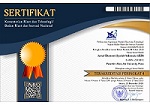The Disclosure of Sharia Non-Compliance Income: Comparative Study between Full-fledged and Subsidiaries Malaysian Islamic Banks
Abstract
The purpose of this paper is to analyze to what extend Islamic banks in Malaysia practice disclosure regarding Sharia non-compliant income. Furthermore, this paper also investigates how bank distribute the Sharia non-compliant income. This paper acquires qualitative approach. The qualitative approach is adopted by doinga document analysisabout the literatures from previous studies that the Sharia non-compliant income.Based on the data collected, Bank Islam clearly and properly discloses its Sharia non-compliance income and we recommend any other Islamic banks to follow it. Also, the study find out that does not matter whether they are full-fledge or subsidiaries, the practice is quite the same.
Full Text:
PDFReferences
AAOIFI. (2010). Sharia Standards for Islamic Financial Institutions. Bahrain: AAOIFI.
Ahmad Salman , S. (2018). SHARI’AH NON-COMPLIANCE RISK MANAGEMENT IN TAKAFUL INDUSTRY. 10.
Al Manaseer, M. (2007), “The Determinants of Islamic and Traditional Bank Profitability: Evidence from the Middle East”, PhD Thesis, University of the West of England.
Ayub, M. (2007). Understanding Islamic Finance. Proceedings of the Academy of Natural
Bank Negara Malaysia. (2014). Istisna Concept Paper. Kuala Lumpur: BNM.
BNM. (2009). Prudential Regulation and Supervisory Framework Introduction, 99.
Fatai, B. O. (2012). Can Islamic Banking Work in Nigeria? Journal of Sustainable Development in Africa, 14(2), 25-40.
Ghazali, N. b. (2014). Tawarruq in Malaysian Financing System: A Case Study on Commodity Murabahah Product at Maybank Islamic Berhad. Kuala Lumpur: University of Malaya.
Hubbard, D. W. (2007). How to Measure Anything, Finding the Value of Intangibles in Business. New Jersey: John Wiley & Son.
IFSA. (2013). Islamic Financial Services Act 2013. Islamic Financial Services Act 2013, 1–
IFSB-10. (2009). Guiding Principles on Shari’ah Governance Systems for Institutions Offering Islamic Financial Services. Islamic Financial Service Board (IFSB). https://doi.org/10.1016/0198-0149(86)90009-9
Islamic Financial Services Board. (2005). IFSB-1: Guiding Principles on Risk Management for Institutions (other than Insurance Institutions). Kuala Lumpur: IFSB.
Islamic Financial Services Board. (2013). IFSB-15: Revised Capital Adequacy Standard for IIFS. Kuala Lumpur: IFSB.
Jarhi, Mabid Ali al- and Iqbal, Munawar (2001), Islamic Banking: FAQs, Jeddah: Islamic Research and Training Institute, Occasional Paper No. 4.
Khiyar, K. A. 2012. Islamic Banking and Econimic Growth: A Review. The Journal of Applied Business Research, 28(5), pp. 943–956
Maruf Olayemi , A. (2017). THE CHALLENGES OF SHARIA COMPLIANCE IN THE ISLAMIC BANKING PRACTICES: WHETHER IBN AL-QAYYIM'S PRINCIPLES OF MUAMALAT BE. 14.
Mohd, Yusoff, H. 2004. Halal certification scheme, Standard & Quality News 11, 4-5.
Mokhtar, S. A., Alias, R. A. and Abdul Rahman, A. (2006). Assessing Academic Computing in Malaysian Higher Education: A Value Chain Approach. Journal of Institutional Research South East Asia, 4 (12), 59-92.
Muda, Muhamad. & Jalil, Abdullaah. (2007), “Islamic Financial Product Development: Sharia Analysis” Working Paper - International Conference on Islamic Banking and Finance (IICiBF). International Islamic University Malaysia. April 2007.
Oz, e., Khokher, Z. u., Ali, M. M., & Rosman, R. (2016). Shari'ah Non-Compliance Risk in the Banking Sector: Impact on Capital Adequacy Framework of Islamic Banks. IFSB Working Paper Series, 1-82.
Reyazat, F. (2012). Risk Management Framework in Islamic Banking: Basel II and Basel III, Challanges and Implications in Islamic Banking. Money and Economy, 6(2), 69-122.
Rosman , R., Che Azmi, A., & Amin, S. (2017). DISCLOSURE OF SHARI’AH NON-COMPLIANCE INCOME BY ISLAMIC BANKS IN MALAYSIA AND BAHRAIN. 14.
Rosman, R., Azmi, A. C., & Amin, S. N. (2017). Disclosure of Shari'ah Non-Compliance
Income by Islamic Banks in Malaysia and Bahrain. International Journal of Business and Society, 18, 45-58.
Sciences of Philadelphia (Vol. 13). West Sussex PO19 8SQ, England: John Wiley & Sons Ltd, The Atrium, Southern Gate, Chichester,. https://doi.org/10.1155/1915/93252
Tjittes 2008, R.P.J.L. Tjittes, Islamitisch financieren in Nederland, Rechtsgeleerd Magazijn Themes, 2008-4, p.136144 http://chrju.seasites.nl/customers/chrju.seasites.nl /documents /R.P.J.L.%20Tjittes%20-%20Islamitisch% 20 financieren% 20in%20 Nederland.pdf
Yasin 2007, N. M. Yasin, Legal aspects of Islamic Banking:Malaysian Experience, Islamic Development Bank, 2007, p. 215-238 http://ebookbrowse.com/gdoc.php?id= 346527 229&url=e8420bf2c9d82f59213b0ed4fcf674cc
DOI: http://dx.doi.org/10.21927/jesi.2019.9(2).104-117

This work is licensed under a Creative Commons Attribution-ShareAlike 4.0 International License.
Editorial Office:
Faculty of Islamic Economics and Business, Universitas Alma Ata
Jl. Brawijaya No.99, Jadan, Tamantirto, Kec. Kasihan, Kabupaten Bantul, Daerah Istimewa Yogyakarta 55184

JESI by http://ejournal.almaata.ac.id/index.php/JESI is licensed under a Creative Commons Attribution-ShareAlike 4.0 International License.





